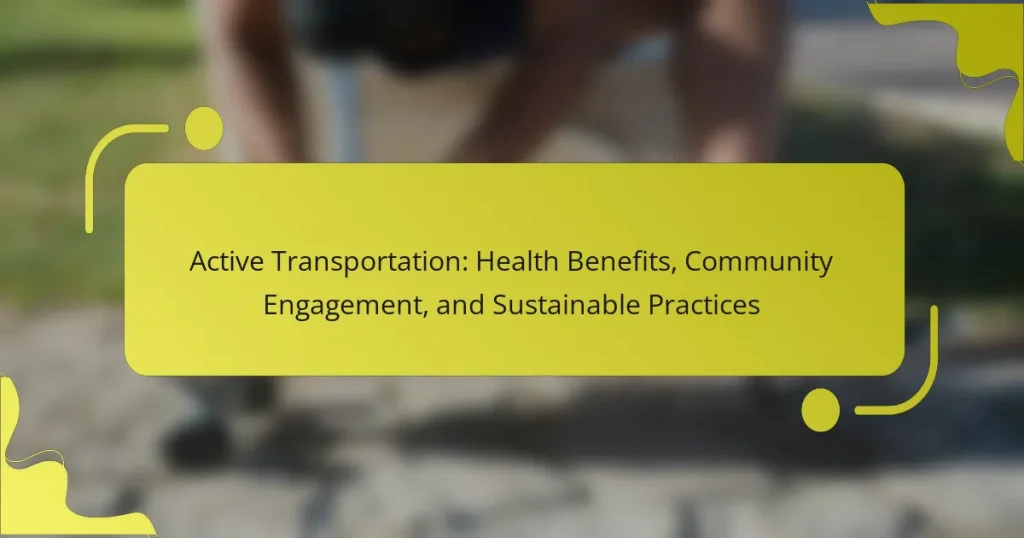Active transportation offers significant health benefits, enhances community engagement, and promotes sustainable practices. It reduces obesity risk and improves cardiovascular fitness while fostering social interactions. Communities that embrace active transportation initiatives report stronger bonds and higher social cohesion. Sustainable practices, such as developing bike lanes and pedestrian pathways, contribute to a cleaner environment and equitable transportation options for all.

What are the health benefits of active transportation?
Active transportation significantly improves physical health, mental well-being, and community engagement. It reduces obesity risk, enhances cardiovascular fitness, and promotes social interaction. Studies show that active transportation can lower stress levels and improve mood. Additionally, it contributes to environmental sustainability by reducing carbon emissions.
How does active transportation improve cardiovascular health?
Active transportation significantly improves cardiovascular health by enhancing physical activity levels. Regular activities like walking or cycling strengthen the heart, lower blood pressure, and improve circulation. Studies show that individuals engaging in active transportation have a lower risk of heart disease. Additionally, it promotes weight management, reducing obesity-related cardiovascular risks.
Which mental health benefits are associated with active transportation?
Active transportation offers significant mental health benefits, including reduced anxiety and depression. Engaging in walking or cycling fosters social connections and community engagement, enhancing overall well-being. Regular physical activity from active transportation improves mood and cognitive function, leading to a healthier lifestyle.
What role does active transportation play in weight management?
Active transportation significantly aids weight management by promoting regular physical activity. Engaging in walking, cycling, or using public transport with active components increases daily energy expenditure, contributing to caloric balance. Studies show that individuals who incorporate active transportation into their routines can maintain a healthier weight compared to those who rely solely on motorized transport. Additionally, this practice fosters community engagement and supports sustainable transportation methods, enhancing overall well-being.

How does active transportation foster community engagement?
Active transportation fosters community engagement by encouraging social interactions and collective activities. It promotes shared experiences, such as walking or biking together, which strengthen community bonds. Studies show that neighborhoods with accessible walking and biking infrastructure report higher levels of social cohesion. This engagement fosters a sense of belonging, as residents participate in local events and initiatives, enhancing overall community well-being. Additionally, active transportation initiatives often involve community input, creating a collaborative environment that empowers residents to shape their surroundings.
What community programs promote active transportation initiatives?
Community programs that promote active transportation initiatives include bike-sharing schemes, walking school buses, and public transit enhancements. These programs encourage healthier lifestyles, reduce traffic congestion, and lower carbon emissions. For example, cities like Portland and Copenhagen have successfully implemented these initiatives, demonstrating significant increases in cycling and walking rates. Engaging local stakeholders fosters community support and ensures the sustainability of these programs.
How does active transportation enhance social interactions?
Active transportation enhances social interactions by fostering community engagement and connection among individuals. Walking or cycling in shared spaces encourages spontaneous conversations and collaboration. Research shows that neighborhoods with pedestrian-friendly infrastructure experience higher levels of social cohesion. This active mode of transport creates opportunities for residents to meet, share experiences, and build relationships, ultimately contributing to a stronger community fabric.
Which local events encourage active transportation participation?
Local events that encourage active transportation participation include community bike rides, walking challenges, and car-free days. These events promote physical activity, enhance community engagement, and support sustainable practices. For example, city-sponsored bike-to-work days often see increased participation, fostering a culture of cycling. As a result, these events not only improve public health but also reduce traffic congestion and emissions.

What sustainable practices are integrated into active transportation?
Active transportation integrates sustainable practices such as promoting walking and cycling, reducing carbon emissions, and enhancing community health. These practices encourage local infrastructure development like bike lanes and pedestrian pathways, fostering a cleaner environment. Additionally, they support social equity by providing accessible transportation options for all community members.
How does active transportation reduce carbon emissions?
Active transportation significantly reduces carbon emissions by promoting walking, cycling, and public transit use. These modes produce minimal to zero emissions compared to motor vehicles. For instance, a study shows that if urban residents shifted to active transportation, cities could reduce greenhouse gas emissions by up to 30%. Additionally, increased active transportation fosters community engagement and healthier lifestyles, creating a positive feedback loop for sustainable practices.
What are the economic benefits of investing in active transportation infrastructure?
Investing in active transportation infrastructure yields significant economic benefits. These investments boost local economies by increasing accessibility, enhancing property values, and reducing transportation costs.
Active transportation infrastructure, such as bike lanes and pedestrian pathways, encourages more people to walk or cycle. As a result, local businesses benefit from increased foot traffic. Studies show that areas with well-developed active transportation options see a rise in retail sales.
Moreover, these investments reduce healthcare costs by promoting healthier lifestyles. A decrease in vehicle use leads to fewer traffic accidents and lower emissions, contributing to a cleaner environment.
In summary, active transportation infrastructure fosters economic growth, improves public health, and enhances community engagement.
Which innovative technologies support sustainable active transportation?
Innovative technologies that support sustainable active transportation include electric bikes, smart traffic management systems, and mobile apps for route planning. These technologies enhance efficiency, reduce carbon footprints, and promote community engagement. Electric bikes provide an eco-friendly alternative for commuting, while smart traffic systems optimize traffic flow to minimize congestion. Mobile apps encourage active transportation by offering real-time information on routes and public transit options. Each technology contributes to a more sustainable and health-conscious urban environment.

How do cultural perceptions influence active transportation choices?
Cultural perceptions significantly shape active transportation choices by influencing attitudes, behaviors, and community norms. Factors such as social acceptance, perceived safety, and the visibility of active transportation in public life affect decisions to walk or cycle.
In many cultures, active transportation is viewed positively, linked to health and environmental sustainability. For instance, cities with strong cycling cultures promote infrastructure that encourages biking, making it a preferred choice. Conversely, in areas where car usage is predominant, walking and cycling may be seen as less desirable.
Community engagement plays a crucial role in shifting perceptions. Initiatives that highlight the benefits of active transportation can foster a supportive environment. Programs that involve local residents in planning and decision-making can lead to increased participation and a shift in cultural norms.
Sustainable practices are often integrated into the cultural fabric of communities that prioritize active transportation. This integration not only enhances public health but also contributes to a collective identity that values environmental stewardship and social well-being.
What regional differences exist in active transportation adoption?
Regional differences in active transportation adoption vary significantly due to factors like infrastructure, culture, and policy. Urban areas often show higher adoption rates due to better facilities and public support. For instance, cities like Amsterdam and Copenhagen prioritize cycling, resulting in over 60% of commutes by bike. In contrast, rural regions may lack necessary infrastructure, leading to lower engagement. Additionally, socioeconomic factors influence participation; higher income areas tend to invest more in active transportation initiatives. Understanding these differences helps tailor strategies to enhance active transportation across diverse communities.
How do demographics shape active transportation behaviors?
Demographics significantly influence active transportation behaviors by shaping preferences and accessibility. Factors such as age, income, education, and urban design affect how communities engage in walking, cycling, and public transit use. For instance, younger populations often favor cycling due to lifestyle choices, while older adults may prefer walking for health benefits. Furthermore, higher income levels correlate with greater access to safe transportation infrastructure, enhancing community engagement in active transportation. Urban areas with comprehensive public transit systems encourage diverse demographics to utilize these options, promoting sustainable practices.

What challenges do communities face in promoting active transportation?
Communities face various challenges in promoting active transportation, including infrastructure limitations, funding constraints, and public awareness. Lack of safe routes discourages walking and cycling, while insufficient funding hampers development. Moreover, many residents may not recognize the health and environmental benefits of active transportation, leading to low engagement. Additionally, cultural and social factors can influence preferences for car travel over walking or biking. Addressing these challenges requires comprehensive community engagement and targeted policy initiatives.
Which common barriers hinder active transportation adoption?
Common barriers hindering active transportation adoption include safety concerns, lack of infrastructure, and cultural attitudes. Safety concerns arise from perceived risks associated with cycling or walking in traffic. Insufficient infrastructure, like bike lanes and sidewalks, limits accessibility. Cultural attitudes, including social norms favoring car use, discourage active transportation.
How can communities address safety concerns related to active transportation?
Communities can enhance safety for active transportation by implementing infrastructure improvements, promoting awareness, and fostering collaboration.
First, cities can invest in dedicated bike lanes and pedestrian pathways to separate active transport users from motor vehicles. This reduces accidents and encourages more people to walk or cycle.
Second, public education campaigns can inform residents about the benefits of active transportation and safe practices. Increased awareness can lead to more responsible behavior among all road users.
Lastly, community engagement through partnerships with local organizations can address specific safety concerns. Regular feedback from residents helps identify problem areas and develop targeted solutions.

What unique attributes distinguish successful active transportation programs?
Successful active transportation programs stand out due to their strong community involvement, comprehensive infrastructure planning, and effective promotion of health benefits. Community engagement fosters a sense of ownership and encourages participation. Infrastructure planning ensures safe and accessible routes for all users. Programs that highlight health benefits, such as improved physical fitness and reduced air pollution, attract more participants. Additionally, unique attributes like tailored educational campaigns and partnerships with local organizations enhance program effectiveness.
Which cities have implemented exemplary active transportation strategies?
Cities like Copenhagen, Amsterdam, and Portland have implemented exemplary active transportation strategies. These cities prioritize cycling, walking, and public transit, resulting in improved public health and reduced carbon emissions. Copenhagen features extensive bike lanes, with over 60% of residents commuting by bicycle daily. Amsterdam integrates cycling into urban planning, ensuring safety and accessibility. Portland promotes active transportation through community engagement and innovative infrastructure, achieving a 20% increase in biking rates over the past decade.
How do policy frameworks support active transportation initiatives?
Policy frameworks significantly enhance active transportation initiatives by providing structured support and resources. They establish guidelines that encourage walking, cycling, and public transit use, fostering healthier communities. For instance, policies may allocate funding for infrastructure improvements, such as bike lanes and pedestrian pathways, which directly increase participation in active transportation.
Moreover, frameworks can promote community engagement by incorporating public feedback into planning processes. This participatory approach ensures that initiatives meet local needs and preferences, ultimately leading to higher adoption rates. Additionally, policies that emphasize sustainability can align active transportation with broader environmental goals, reducing carbon footprints and promoting cleaner air.
Overall, effective policy frameworks create an ecosystem that supports active transportation through investment, community involvement, and environmental responsibility.
What role do local stakeholders play in active transportation success?
Local stakeholders are crucial for the success of active transportation initiatives. They foster community engagement, ensuring that projects align with local needs and preferences. Stakeholders, including residents, businesses, and local governments, contribute valuable insights that shape effective transportation solutions. Their involvement enhances public support, increases funding opportunities, and promotes sustainable practices. Engaging these groups also leads to better-designed infrastructure, ultimately improving health outcomes and community connectivity.
What best practices can enhance active transportation efforts?
Implementing best practices can significantly enhance active transportation efforts. Prioritizing infrastructure improvements, such as dedicated bike lanes and pedestrian pathways, encourages safe usage. Community engagement through events and surveys fosters public interest and input. Education campaigns highlighting health benefits and environmental impacts create awareness. Collaboration with local organizations can amplify outreach and resources.




